ReSeaRch centRe foR aPPlied PSychology (RecaP) - Health ...
ReSeaRch centRe foR aPPlied PSychology (RecaP) - Health ...
ReSeaRch centRe foR aPPlied PSychology (RecaP) - Health ...
You also want an ePaper? Increase the reach of your titles
YUMPU automatically turns print PDFs into web optimized ePapers that Google loves.
40<br />
than in those without. Another study, not included in the<br />
thesis but part of the wider project, examined symptoms<br />
of anxiety in twins with or without movement disorder, and<br />
found more symptoms of anxiety in twins with movement<br />
disorder than in those without, although if both twins had<br />
movement disorder, this effect was not as marked. The<br />
papers also gave insight into twin perceptions of family<br />
functioning and of the relationship between twins. The<br />
study culminated in the hypothesis that, rather than being<br />
different disorders as currently classified in major medical<br />
classification systems, movement disorders fall on a<br />
continuum from mild Developmental Coordination Disorder<br />
to Cerebral Palsy.<br />
Publications<br />
Pearsall-Jones, Jillian G., Piek, Jan P., Rigoli, Daniela, Martin,<br />
Neilson C., & Levy, Florence (2011). Motor disorder and<br />
anxious and depressive symptomatology: A monozygotic cotwin<br />
control approach. Research in Developmental Disabilities,<br />
32 (4), 1245-1252.<br />
Pearsall-Jones, J. G., Piek, J. P. Steed, L., McDougall, M. R., &<br />
Levy, F. (2011). Monozygotic twins concordant and discordant<br />
for DCD: Two sides to the story. Twin Research and Human<br />
Genetics, 14, 79-87.<br />
Pearsall-Jones, J. G., Piek, J. P. & Levy, F. (2010). Etiological<br />
pathways for developmental coordination disorder and<br />
attention-deficit/hyperactivity disorder: shared or discrete?<br />
Expert Review of Neurotherapeutics, 10, 491-494.<br />
Pearsall-Jones, J. G., Piek, J. P., & Levy, F. (2010).<br />
Developmental Coordination Disorder and Cerebral Palsy:<br />
Categories or a Continuum? Human Movement Science, 29,<br />
787-798.<br />
Pearsall-Jones, J. G., Piek, J. P., Rigoli, D., Martin, N. C., & Levy,<br />
F. (2009). An investigation into etiological pathways of DCD<br />
and ADHD using a monozygotic twin design. Twin Research<br />
and Human Genetics, 12, 381-391.<br />
Pearsall-Jones, J. G., Piek, J. P., Martin, N. C., Rigoli, D., Levy, F.,<br />
& Hay, D. A. (2008). A monozygotic twin design to investigate<br />
etiological factors for DCD and ADHD. Journal of Pediatric<br />
Neurology, 6, 209-219.<br />
Piek, J. P., Rigoli, D., Pearsall-Jones, J. G., Martin, N. C.,<br />
Hay, D. A., Bennett, K. S., & Levy, F. (2007). Depressive<br />
symptomatology in child and adolescent twins with<br />
attention-deficit hyperactivity disorder and/or developmental<br />
coordination disorder. Twin Research and Human Genetics,<br />
10, 587-596.<br />
Bennett, K. S., Hay, D. A. Piek, J. P., Pearsall-Jones, J. G., Levy,<br />
F., & Martin, N. C. (2006). The Australian Twin ADHD Project:<br />
current status and future directions. Twin Research and<br />
Human Genetics, 9(6), 718-26.<br />
Hay, D. A., McStephen, M. Levy, F., & Pearsall-Jones, J. G.<br />
(2002). Recruitment and attrition in Twin Register studies of<br />
childhood behavior: The example of the Australian Twin ADHD<br />
Project. Twin Research, 5(5), 324-328.<br />
SHARON ELSLEY<br />
Cognitive social and emotional factors<br />
in young boys at risk of disruptive<br />
behaviour disorders.<br />
Supervisors: Jan Piek, Murray Dyck (Griffith University)<br />
This study aimed to determine the relationship between<br />
a subset of cognitive, social and emotional factors which<br />
may be related to disruptive behaviours in young boys at<br />
risk of disruptive behaviour disorders. An aim was to create<br />
a profile from these variables which would best explain<br />
disruptive behaviours and social skills deficits in two age<br />
groups in this cross-sectional study. The boys were recruited<br />
from low-socioeconomic communities in Western Australia,<br />
and they had not previously been identified as being at<br />
risk of disruptive behaviour disorders. Three studies were<br />
conducted. Study 1 investigated 4 to 5 year old boys (N=43)<br />
on Verbal IQ (Wechsler, 1989), Spatial Perspective Taking<br />
(Flavell, Botkin, Fry, Wright & Jarvis, 1968), Perceptual<br />
Organisation (Wechsler, 1989), Emotion Understanding<br />
and Emotion Recognition (ERS: Dyck, Ferguson & Schochet,<br />
2001), and Dispositional Empathy (Bryant, 1982) or<br />
Concern for Others. Study 2 was an observation of the boys<br />
from Study 1 for Parent-Child Mutuality (Deater-Deckard,<br />
Pylas & Petrill, 1997), to examine the dyadic relationship<br />
between mother and son as a measure of their social skills<br />
and behaviours. Study 3 investigated 7 to 8 year old boys<br />
(N=46) on Verbal IQ (Wechsler, 1992), Spatial Perspective<br />
Taking (Piaget & Inhelder, 1956), Emotion Understanding<br />
and Emotion Recognition (ERS: Dyck et al. 2001),<br />
Dispositional Empathy (Bryant, 1982), and parent and<br />
teacher ratings on the Social Skills Rating Scale (Gresham &<br />
Elliott, 1990).<br />
Results for Study 1 showed that Spatial Perspective Taking<br />
(SPt) was significantly lower for the boys with disruptive<br />
behaviours compared to the non-disruptive group and<br />
SPt was the defining factor for group membership, with<br />
Emotion Recognition losing significance due to the<br />
analysis of multiple univariate variables. Mother-reported<br />
internalising and social problems were significantly<br />
higher for the disruptive group. For Study 2, boys<br />
with disruptive behaviours and their mothers showed<br />
lower mutuality with significantly less reciprocity, less<br />
emotionally responsiveness and less cooperation than<br />
the non-disruptive boys and their mothers. The disruptive<br />
group also had lower mother-son dyadic positivity and<br />
communication, and higher negativity. Dispositional<br />
Empathy or Concern for Others predicted Mother-Child<br />
Mutuality (MCM). In Study 3, the boys with disruptive<br />
behaviours had significantly lower Verbal IQ, Emotion



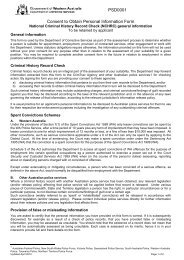
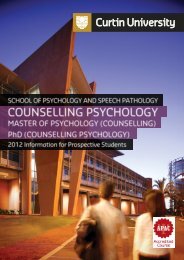
![Mental health commission report July 2010 - June 2011 [.pdf]](https://img.yumpu.com/50755705/1/184x260/mental-health-commission-report-july-2010-june-2011-pdf.jpg?quality=85)
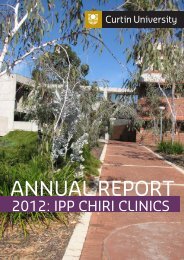


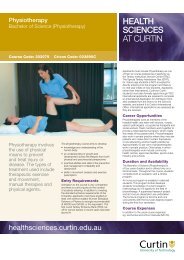

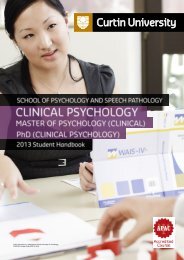

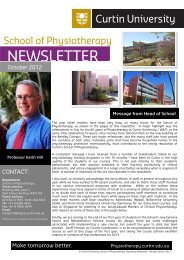

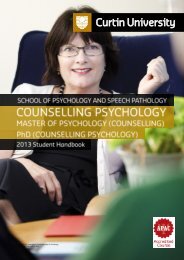
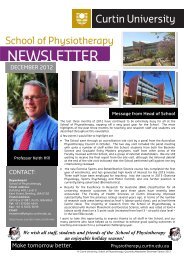
![2007 Annual Report [.pdf] - Health Sciences - Curtin University](https://img.yumpu.com/44476724/1/184x260/2007-annual-report-pdf-health-sciences-curtin-university.jpg?quality=85)